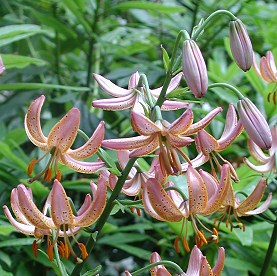Lily ( Lilium ) Seeds
Anyone can grow beautiful lilies from seed with a bit of patience and care.
Growing lilies from seed is an easy and economical means of acquiring a distinctive collection of lilies, of freeing species of virus, of maintaining genetic diversity and, for the hybridizer, an essential step in creating new cultivars.
The most important requirement for the planting mix is drainage while retaining moisture. Planting mixes containing a lot of peat moss are poor. They are often too wet and they tend to dry out easily and are difficult to re-moisten. Such mixes also have a tendency to "cake," leaving the top of the pot moist while the bottom is dry. Packaged planting mixes high in peat moss need at least an equal amount of sand, soil, ground bark or perlite added.
Indoor germination: Lily seeds are not difficult to germinate indoors and to grow under lights, although some people may find it easier to just plant the seeds outdoors in the spring. Seeds germinated in the fall may flower the following summer if given adequate growing conditions, but that isn't too common. Planting containers should be at least 4-5 inches deep to allow deep root development. Inexpensive 16-ounce plastic drinking cups are good when four or five 3/8" holes are drilled in the bottom. These are suitable for up to 15 seeds each.
Plant seeds about 1/4 inch deep and keep moist. Check individual type for optimum temperatures. A plastic sandwich bag placed loosely over each pot will keep moisture in and cut down maintenance for a few weeks. However, plastic bags can act as greenhouses and overheat the seeds if placed in direct sunlight or too close to lights. Pots can be covered with cardboard or newspaper to keep the mix from drying out.
Provide seedlings with artificial light as soon as they begin to germinate. Regular fluorescent lights are adequate, but special grow lights are slightly better although more expensive. Halogen lights are expensive to purchase and to operate but the results are rewarding. Feed the germinating seeds with a balanced soluble fertilizer about once a week, half strength for soil, higher for sand or vermiculite mixes. Pot-grown seedlings may need additional nitrogen. A twice-a-month feeding with a teaspoon of ammonium sulfate per gallon of water may be beneficial. One or two treatments with micro-elements or with chelated iron will also help. Indoor grown seedlings may be attacked by sucking insects which can quickly do considerable damage. Use a systemic plant and pot insecticide at the first sign of infestation. Lily seedlings are not immune to damping off disease. A heat-sterilized medium with good drainage should overcome the problem. The planting mix should be kept moist but not overly wet. Threat the planting medium with a fungicide if damping off or bulb rot appears or transplant the seedlings to a clean sterilized medium after washing the seedlings free of old soil.
Starting seeds outdoors: It is usually easier to plant seeds in containers placed outdoors rather than planting directly into the ground. Use clean 6-8" plastic pots, gallon size cans or thoroughly cleaned flats.
Protect the emerging seedlings from heavy rain and hail which can beat down emerging cotyledons and leaves by placing containers in a sheltered location with adequate light. Cold frames and greenhouses are excellent and temporary shelters can be made of discarded windows, fiberglass sheeting or plastic hung over a frame. Prevent overheating of the poting mix by giving containers afternoon shade or partly plunging them in bark or sawdust.
During the spring months keep containers moist but not overly wet. In hot summer weather it is difficult to over-water if drainage is quick. It is best to apply enough water so that excess water comes out of the drainage holes as too little water will cause soil caking. Feed with a balanced soluble fertilizer as soon as the seedlings emerge. There after fertilize about every two weeks. Container-grown plants heavily watered during the summer months will benefit from extra nitrogen. Sprinkle a few ammonium sulfate crystals on the soil or water with a teaspoon of ammonium sulfate per gallon of water. Be careful about applying granular fertilizer to young seedlings as you can end up killing the seedlings if the fertilizer comes in contact with the leaves or is too close to the bulbs.
Grow in average, medium moisture, slightly acidic, well-drained soils in full sun to part shade. Prefers rich organic loams. Best sited with the upper parts of the plant in full sun and the roots in shade. Mulch around plants to keep root zones cool. Plant bulbs 4-6” deep in fall. Potted plants may be planted any time from spring to fall. Bulbs need good moisture year-round. Do not allow soil to dry out. Remove flowers as they fade to reduce the setting of seed. After bloom, cut plants back only after leaves and stems turn yellow. Bulbs are rhizomatous.


